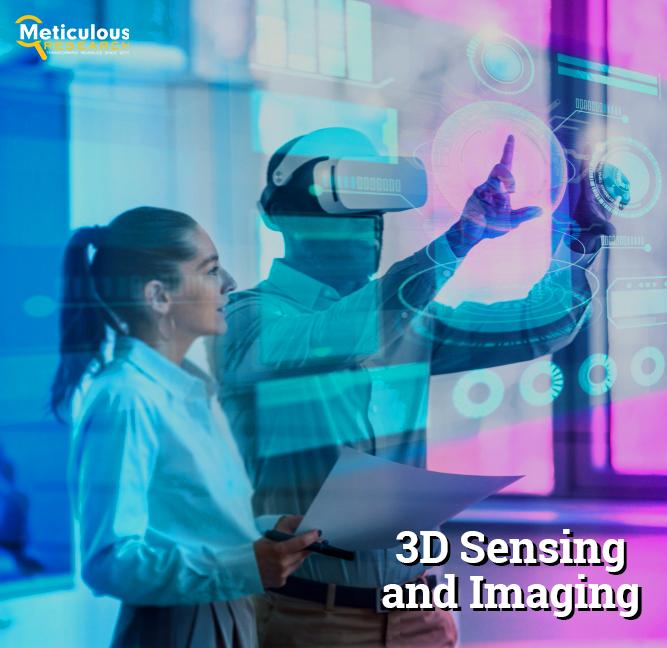3D Sensing and Imaging Market to be Worth $115.3 Bn by 2030

According to the latest publication from Meticulous Research®, the 3D sensing and imaging market is expected to reach $115.3 billion by 2030, at a CAGR of 24.2% during the forecast period 2023–2030. The growth of the 3D sensing & imaging market is driven by the rising demand for devices with 3D sensing capabilities, growing preference for VCSELs over LEDs, rising demand for ADAS, and growing use of 3D imaging sensors across industries. Moreover, rising demand for optical 3D sensing capabilities in industrial applications, increasing government initiatives supporting industrial automation, rising awareness regarding the benefits of 3D imaging technology in medical applications, and increasing integration of 3D accelerometers in smartphones and gaming consoles.
However, the high installation cost restrains the market's growth to some extent. Additionally, the increasing need to improve the accuracy, effectiveness, and robustness of 3D sensing technologies poses challenges for the 3D sensing & imaging market growth. Besides, the increasing adoption of liquid lenses for better vision and the rise in adoption of Industry 4.0 technologies are the key trends observed in the 3D sensing & imaging market.
Download Sample Report Here: https://www.meticulousresearch.com/download-sample-report/cp_id=5358
The 3D sensing and imaging market is segmented by type, technology/modality, application, and end-use industry. The study also evaluates industry competitors and analyzes the market at the regional and country levels.
Based on type, the 3D sensing and imaging market is segmented into 3D sensing and 3D imaging. In 2023, the 3D imaging segment is expected to account for the larger share of the global 3D sensing and imaging market. The growth of this segment is attributed to the increasing adoption of cloud-based 3D imaging solutions and the rising demand for 3D image sensors from industries, including media & entertainment, architecture and construction, and archaeological studies. However, the 3D sensing segment is projected to register the highest CAGR during the forecast period.
Based on technology/modality, the 3D sensing and imaging market is segmented into LiDAR, stereoscopic imaging/vision, time-of-flight (ToF), structured light, laser triangulation, radar, ultrasound, x-ray, and other technologies. In 2023, the LiDAR segment is expected to account for the largest share of the global 3D sensing & imaging market. The large market share of this segment is attributed to the rapid growth of automated driving vehicles, the rising adoption of UAVs, and a surge in the need for better geospatial solutions that provide essential information for reliable object detection and collision avoidance by generating precise 3D images of the vehicle. However, the structured light segment is expected to record the highest CAGR during the forecast period.
Based on application, the 3D sensing & imaging market is segmented into security & surveillance, mapping & imaging, industrial automation, medical imaging, navigation, scanning, surveying, and other applications. In 2023, the security & surveillance segment is expected to account for the largest share of the global 3D sensing & imaging market. The large market share of this segment is attributed to the rising need for 3D imaging mobile surveillance, the increasing implementation of 3D LiDAR cameras to secure various temporary and remote sites, such as construction sites, storage areas, and parking areas, and the growing need for innovative outdoor remote security applications. However, the security & surveillance segment is also expected to record the highest CAGR during the forecast period.
Based on end-use industry, the 3D sensing and imaging market is segmented into automotive, transportation & logistics, consumer electronics, defense & aerospace, healthcare, manufacturing & warehouses, media & entertainment, architecture, engineering & construction, and other end-use industries. In 2023, the consumer electronics segment is expected to account for a share of the global 3D sensing and imaging market. The growth of this segment is mainly attributed to the rising adoption of smartphones, cameras, and laptops due to the growth in per capita income, remote work trend, and changing consumer lifestyles. However, the healthcare segment is projected to register the highest CAGR during the forecast period.
Based on geography, the 3D sensing and imaging market is segmented into North America, Europe, Asia-Pacific, Latin America, and the Middle East & Africa. In 2023, North America is expected to account for the largest share of the global 3D sensing & imaging market. The major factors driving the market's growth are the rising demand for 3D sensing optical technologies such as face recognition, facial payments, and augmented/virtual reality in various sectors, including healthcare, a surge in demand for virtualized solutions in robotics, and high adoption of advanced technologies to ensure the security of remote areas. However, Asia-Pacific is projected to register the highest CAGR during the forecast period.
Get Customized Report: https://www.meticulousresearch.com/request-customization/cp_id=5358
Key Players
The key players operating in the 3D Sensing and imaging market are STMicroelectronics N.V. (Switzerland), Infineon Technologies AG (Germany), Microchip Technology Inc. (U.S.), Viavi Solutions Inc. (U.S.), Rockwell Automation, Inc. (U.S.), KEYENCE CORPORATION (Japan), Suteng Innovation Technology Co., Ltd. (China), Autodesk Inc. (U.S.), Cognex Corporation (U.S.), OMNIVISION Technologies, Inc. (U.S.), SICK AG (Germany), Panasonic Holdings Corporation (Japan), Sony Group Corporation (Japan), Lumentum Holdings Inc. (U.S.), FARO Technologies, Inc. (U.S.), Occipital, Inc. (U.S.), LMI Technologies Inc. (Canada) (A Subsidiary of TKH Group N.V.), Trimble Inc. (U.S.), and Balluff GmbH (Germany).
Contact Us:
Meticulous Research®
Email- sales@meticulousresearch.com
Contact Sales- +1-646-781-8004
Connect with us on LinkedIn- https://www.linkedin.com/company/meticulous-research
- Art
- Causes
- Crafts
- Dance
- Drinks
- Film
- Fitness
- Food
- Giochi
- Gardening
- Health
- Home
- Literature
- Music
- Networking
- Altre informazioni
- Party
- Religion
- Shopping
- Sports
- Theater
- Wellness


